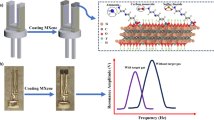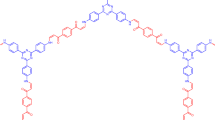Abstract
Organic thin-film transistor sensors have been recently attracting the attention of the plastic electronics community for their potential exploitation in novel sensing platforms. Specificity and sensitivity are however still open issues: in this respect chiral discrimination—being a scientific and technological achievement in itself—is indeed one of the most challenging sensor bench-tests. So far, conducting-polymer solid-state chiral detection has been carried out at part-per-thousand concentration levels. Here, a novel chiral bilayer organic thin-film transistor gas sensor—comprising an outermost layer with built-in enantioselective properties—is demonstrated to show field-effect amplified sensitivity that enables differential detection of optical isomers in the tens-of-parts-per-million concentration range. The ad-hoc-designed organic semiconductor endowed with chiral side groups, the bilayer structure and the thin-film transistor transducer provide a significant step forward in the development of a high-performance and versatile sensing platform compatible with flexible organic electronic technologies.
This is a preview of subscription content, access via your institution
Access options
Subscribe to this journal
Receive 12 print issues and online access
$259.00 per year
only $21.58 per issue
Buy this article
- Purchase on Springer Link
- Instant access to full article PDF
Prices may be subject to local taxes which are calculated during checkout






Similar content being viewed by others
References
Torsi, L. & Dodabalapur, A. Organic thin-film transistors as plastic analytical sensors. Anal. Chem. 77, 380A–387A (2005).
Crone, B. et al. Electronic sensing of vapors with organic transistors. Appl. Phys. Lett. 78, 2229–2231 (2001).
Bernards, D. A. et al. Enzymatic sensing with organic electrochemical transistors. J. Mater. Chem. 18, 116–120 (2008).
Star, A., Gabriel, J.-C. P., Bradley, K. & Grüner, G. Electronic detection of specific protein binding using nanotube FET devices. Nano Lett. 3, 459–463 (2003).
Torsi, L. Organic thin-film transistors as analytical and bioanalytical sensors. Topic issue. Anal. Bioanal. Chem. 384, 309 (2006).
Mcculloch, I. Thin films: Rolling out organic electronics. Nature Mater. 4, 583–584 (2005).
Forrest, S. R. The path to ubiquitous and low-cost organic electronic appliances on plastic. Nature 428, 911–918 (2004).
Jenekhe, S. A. The special issue on organic electronics. Chem. Mater. 16, 4381–4390 (2004).
Janata, J. & Josowicz, M. Conducting polymers in electronic chemical sensors. Nature Mater. 2, 19 (2003).
Torsi, L. et al. Side-chain role in chemically sensing conducting polymer field-effect transistors. J. Phys. Chem. B 107, 7589–7594 (2003).
Huang, J., Miragliotta, J., Becknell, A. & Katz, H. E. Hydroxy-terminated organic semiconductor-based field-effect transistors for phosphonate vapor detection. J. Am. Chem. Soc. 129, 9366–9376 (2007).
Lemaire, M., Delabouglise, D., Garreau, R., Guy, A. & Roncali, J. Enantioselective chiral poly(thiophenes). J. Chem. Soc. Chem. Commun. 658–661 (1988).
Huang, J. et al. Enantioselective discrimination of D- and L-phenylalanine by chiral polyaniline thin films. Adv. Mater. 15, 1158–1161 (2003).
Severin, E. J., Sanner, R. D., Doleman, B. J. & Lewis, N. S. Differential detection of enantiomeric gaseous analytes using carbon black–chiral polymer composite, chemically sensitive resistors. Anal. Chem. 70, 1440–1443 (1998).
de Lacy Costello, B. P. J., Ratcliffe, N. M. & Sivanand, P. S. The synthesis of novel 3-substituted pyrrole monomers possessing chiral side groups: A study of their chemical polymerization and the assessment of their chiral discrimination properties. Synth. Met. 139, 43–55 (2003).
Bodenhöfer, K. et al. Chiral discrimination using piezoelectric and optical gas sensors. Nature 387, 577–580 (1997).
Bodenhöfer, K. et al. Chiral discrimination in the gas phase using different transducers: Thickness share mode resonators and reflectometric interference spectroscopy. Anal. Chem. 69, 3058–3068 (1997).
Hagleitner, C. et al. Smart single-chip gas sensor microsystem. Nature 414, 293–296 (2001).
Crone, B. et al. Organic oscillator and adaptive amplifier circuits for chemical vapor sensing. J. Appl. Phys. 91, 10140–10146 (2002).
Wang, L., Fine, D. & Dodabalapur, A. Nanoscale chemical sensors based on organic thin-film transistors. Appl. Phys. Lett. 85, 6386–6388 (2004).
Wang, L., Fine, D., Torsi, L. & Dodabalapur, A. Nanoscale organic and polymeric field-effect transistors as chemical sensors. Anal. Bioanal. Chem. 384, 310–321 (2006).
Someya, T., Dodabalapur, A., Gelperin, A., Katz, H. E. & Bao, Z. Integration and response of organic electronics with aqueous microfluidics. Langmuir 18, 5299–5302 (2002).
Babudri, F., Farinola, G. M. & Naso, F. Synthesis of conjugated oligomers and polymers: The organometallic way. J. Mater. Chem. 14, 11–34 (2004).
Naso, F. et al. Thin film construction and characterization and gas-sensing performance of a tailored phenylene–thienylene copolymer. J. Am. Chem. Soc. 125, 9055–9061 (2003).
Tanese, M. C. et al. Poly(alkoxyphenylene–thienylene) Langmuir–Schafer thin-films for advanced performance transistors. Chem. Mater. 18, 778–784 (2006).
Torsi, L., Dodabalapur, A., Sabbatini, L. & Zambonin, P. G. Multi-parameter gas sensor based on organic thin-film transistors. Sensors Actuators B 67, 312–316 (2000).
Tanese, M. C., Fine, D., Dodabalapur, A. & Torsi, L. Interface and gate bias dependent response of sensing organic thin-film transistors. Biosens. Bioelectron. 21, 782–788 (2005).
Someya, T., Katz, H. E., Gelperin, A., Lovinger, A. J. & Dodabalapur, A. Vapour sensing with α-ω-dihexylquaterthiophene field-effect transistors: The role of grain boundaries. Appl. Phys. Lett. 81, 3079–3081 (2002).
Tanese, M. C. et al. Nanostructural depth-profile and field-effect properties of poly(alkoxyphenylene–thienylene) Langmuir–Schäfer thin-films. Thin Solid Films 516, 3263–3269 (2008).
Tanese, M. C. et al. Conjugated phenylene–ethynylene polymers bearing glucose substituents as promising active layers in enantioselective chemiresistors. Sensors Actuators B 100, 17–21 (2004).
Babudri, F. et al. Synthesis and chiroptical characterization of an amino acid functionalized dialkoxypoly(p-phenyleneethynylene). Macromolecules 39, 5206–5212 (2006).
Horowitz, G., Hajlaoui, M. E. & Hajlaoui, R. Temperature and gate dependence of hole mobility in polycrystalline oligothiophene thin film transistors. J. Appl. Phys. 87, 4456 (2000).
Torsi, L. et al. Correlation between oligothiophene thin film transistor morphology and vapour responses. J. Phys. Chem. B 106, 12563–12568 (2002).
Tanese, M. C. et al. A poly(phenyleneethynylene) polymer bearing amino acid substituents as active layer in enantioselective solid-state sensors. Proc. SPIE 6192, 61921E (2006).
Horowitz, G. & Haifaoui, M. E. Mobility in polycrystalline oligothiophene field-effect transistors dependent on gate bias. Adv. Mater. 12, 1046 (2000).
Dodabalapur, A. et al. Sensitive four-terminal silicon/organic field-effect chemical vapor sensors. Part of Proc. SPIE 6659, 185 (2007).
Dodabalapur, A., Torsi, L. & Katz, H. E. Organic transistors: Two-dimensional transport and improved electrical characteristics. Science 268, 270–271 (1995).
Kreis, P. & Mosandl, A. Chiral compounds of essential oils. Part XII. Authenticity control of rose oils, using enantioselective multidimensional gas chromatography. Flavour Fragrance J. 7, 199–203 (1992).
<http://www.restek.com/restek/images/external/59889.pdf>.
Zhang, J., Boyd, A., Tselev, A., Paranjape, M. & Barbara, P. Mechanism of NO2 detection in carbon nanotube field effect transistor chemical sensors. Appl. Phys. Lett. 88, 123112 (2006).
Someya, T., Small, J., Kim, P., Nuckolls, C. & Yardley, J. T. Alcohol vapor sensors based on single-walled carbon nanotube field effect transistors. Nano Lett. 3, 877 (2003).
Acknowledgements
We are indebted to E. A. Chandross and G. Horowitz for advice. L. Sabbatini, P. Iliade and M. D. Angione are acknowledged for discussions. We are grateful to L. Dimo for assistance in the LS depositions. Italian MIUR ‘Bando DM 1105 del 9/10/2002 Progetto n.ro 100/2’, Progetto FIRB 2003 ‘SYNERGY RBNE0 3S7XZ_001’ and ‘PRIN-06 Project—2006037708—Plastic bio-FET sensors’ are acknowledged for partial financial support. While the present manuscript was under revision another paper was published (Huang, J., Miragliotta, J., Becknell, A. & Katz, H. E., J. Am. Chem. Soc. 129, 9366-9376 (2007)) proposing a two-layer OTFT sensor.
Author information
Authors and Affiliations
Contributions
All authors have agreed to all the content of the manuscript, including the data as presented.
Corresponding authors
Supplementary information
Rights and permissions
About this article
Cite this article
Torsi, L., Farinola, G., Marinelli, F. et al. A sensitivity-enhanced field-effect chiral sensor. Nature Mater 7, 412–417 (2008). https://doi.org/10.1038/nmat2167
Received:
Accepted:
Published:
Issue Date:
DOI: https://doi.org/10.1038/nmat2167
This article is cited by
-
Sensitive sensors based on bilayer organic field-effect transistors for detecting lithium-ion battery electrolyte leakage
Science China Materials (2022)
-
Electrolyte-gated transistors for enhanced performance bioelectronics
Nature Reviews Methods Primers (2021)
-
Sub-molecular structural relaxation at a physisorbed interface with monolayer organic single-crystal semiconductors
Communications Physics (2020)
-
Morphology modulation and gas sensitivity improvement of indium oxide semiconductor nanomaterials
Journal of Materials Science: Materials in Electronics (2020)
-
General rule for the energy of water-induced traps in organic semiconductors
Nature Materials (2019)



